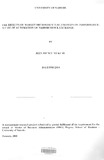| dc.contributor.author | Mukumu, Joel I | |
| dc.date.accessioned | 2013-05-15T12:34:19Z | |
| dc.date.issued | 2008 | |
| dc.identifier.citation | MBA | en |
| dc.identifier.uri | http://erepository.uonbi.ac.ke:8080/xmlui/handle/123456789/23224 | |
| dc.description.abstract | The aim of this study was to assess the improvement in functioning of the Nairobi Stock
Exchange (NSE) following the implementation of new technology and automation of the trading
system. The market had previously been operating on floor based trading system until 11
September, 2006, when it was automated. The study used historical market data. Return and
volume residues and turnover ratios were calculated within the event window period of 31 days.
The analysis was done by comparing the mean and turnover ratio before and after introduction of
automated trading system. The market was separated between Main Investments Market
Segments (MIMS) and Alternative Investments Market Segments (AIMS).
The research found out that there exist no significant difference in terms of returns, volumes, and
liquidity before and after automation. The research therefore concluded that the effect of
automation has not been factored in the market.
In conclusion therefore, the failure by NSE automation to address the interest of the investors of
transparency and immediacy raises concern as to the benefits of micro structure reforms within
the short term. | en |
| dc.description.sponsorship | University of Nairobi | en |
| dc.language.iso | en | en |
| dc.publisher | University of Nairobi | en |
| dc.title | The effects of market microstructure changes on performance: A case of automation of Nairobi Stock Exchange | en |
| dc.type | Thesis | en |
| local.publisher | School of Business, College of Humanities and Social Sciences | en |

